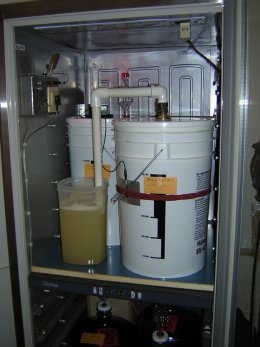Post by EcnerwalPost by JoergPost by Tom BiasiPost by JoergSeriously? Even nowadays? This one is a bulkhead connector meant to
provide a faucet that is fed from a garden hose (for field use,
camping, outdoor events and such). Lead would not be good there.
There are presently regulations regarding lead in plumbing but as early
as 10 years ago it was still being used. Who knows what's in the Chinese
products.
I bought it in Connecticut but who knows where it came from. I wonder if
there is something I could coat it with.
You can remove surface lead with hydrogen peroxide and vinegar.
Good point! Found the peroxide with free shipping, just ordered it:
https://www.walmart.com/ip/Member-s-Mark-Hydrogen-Peroxide-32-Fl-Oz-2-Ct/123453226
Will this stuff harm PVC or can I leave the bulkhead connector installed?
Post by EcnerwalThis is from "How to brew" but IIRC was actually cribbed from NASA.
However, leaving the brass in prolonged contact with acidic wort is
evidently moving you right onto the "left for too long" and dissolving
the copper state - this is not a good thing, for you.
http://howtobrew.com/book/appendices/appendix-b/brewing-metallurgy
Cleaning Brass
Some brewers use brass fittings in conjunction with their wort chillers
or other brewing equipment and are concerned about the lead that is
present in brass alloys. A solution of two parts white vinegar to one
part hydrogen peroxide (common 3% solution) will remove tarnish and
surface lead from brass parts when they are soaked for 5 minutes or less
at room temperature. The brass will turn a buttery yellow color as it is
cleaned. If the solution starts to turn green and the brass darkens,
then the parts have been soaking too long and the copper in the brass is
beginning to dissolve, exposing more lead. The solution has become
contaminated and the part should be re-cleaned in a fresh solution.
Thanks, I bookmarked that.
Post by EcnerwalAs such, I would advise firing up "shopping on the internet" or finding
a person with food-grade plastic for their 3-D printer and getting some
plastic parts to do the job. I would not trust paint, here.
I tried that before, could find any bulkhead connectors that fit a
garden hose thread and then saw that brass one. Brass is quite popular
in brewing:
https://mylhbs.com/Brewing-Equipment-Fittings-%26-High-Temp-Tubing/?subcategory=Brass%2BFittings
I have seen brass fermenter connections in breweries. In my case the
wort does not come into contact with it. It is only exposed to CO2, the
occasional spritz of Starsan and then every 3-4 months when I brew a
Belgian Tripel it'll have kraeusen blow-off belch through it for 3-4 days.
BTW, staining and discoloration even happens with PVC. I just brewed
rounds 48 and 49 and my plastic fermenter not have very noticeable
discolorations that won't come out even with a PBW soak. Each bucket has
only see about 25 batches.
--
Regards, Joerg
http://www.analogconsultants.com/
